The history of personal computers in advertising. Part 2: 1980s
Hi, Habr!
In a previous publication on the history of computers in advertising, I covered the period from the end of 1960 to 1979. The time has come to recall the 1980s: here you will find Speccy, NeXT, Macintosh, and other computers from the time when a 10 MB hard drive cost more than $ 3,000.
After a brief description of the exhibits, I added prices at the time of their sale, and also recalculated them for 2013 (in brackets).
')
Enjoy watching!
Please do not be too strict with the design of the post: I could not find some of the images in the best quality.
If you have something to supplement the collection - please write about it, please, in the comments or in personal messages.
Previous and next parts:
The history of personal computers in advertising. Part 1: 1970s
The history of personal computers in advertising. Part 3: 1990s
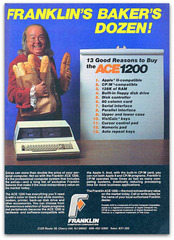


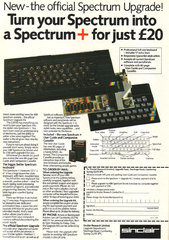
In January 1980, Hewlett-Packard launched the first computer in the series 80 - HP85A. This computer is designed to work with engineering and control applications.
Price: $ 2,750 ($ 8,232)


In the 1980s, Sinclair began to produce a personal computer ZX80. It was the first computer in the UK, the price for which did not exceed £ 100.
Price: $ 199.95 ($ 598.55)
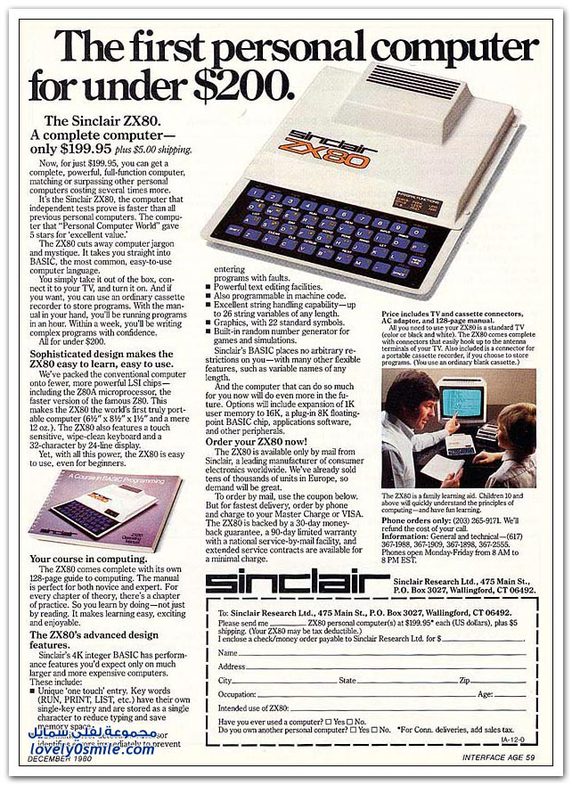
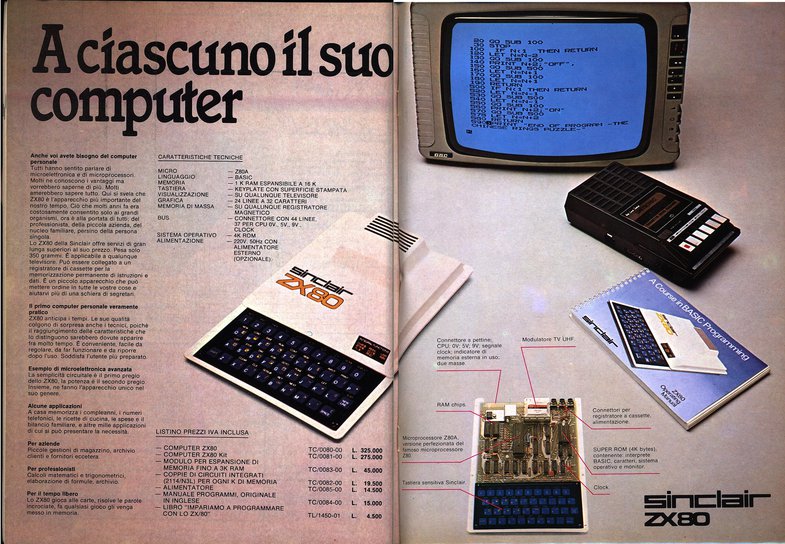
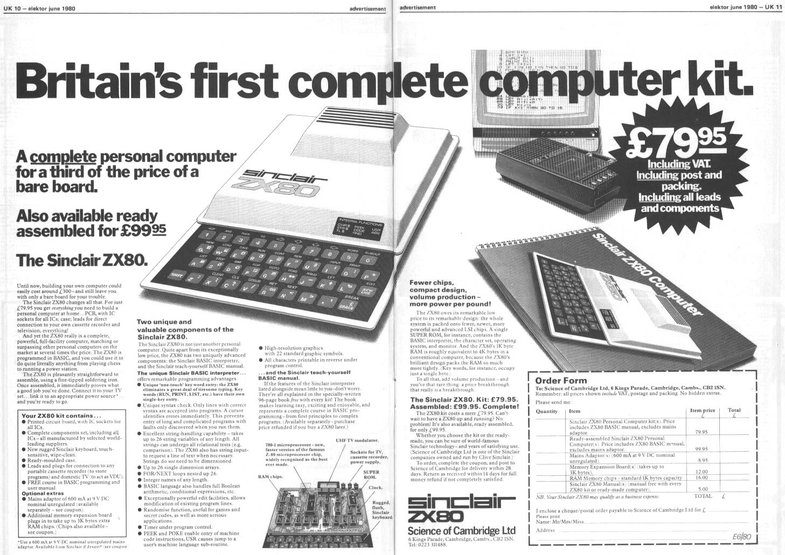
Commodore VIC-20 8-bit color home computer. “Why buy a video game when you can buy a computer for the same money?” It became the first microcomputer whose sales exceeded 1 million units. In total, the people took 2.5 million copies. The initial price was $ 299.95, but then it was lowered to as much as $ 55 - lower than the cost price. We won at the expense of accessories and software. William Shetner (Star Trek) participated in the campaign
Price: $ 55 ($ 164.64)
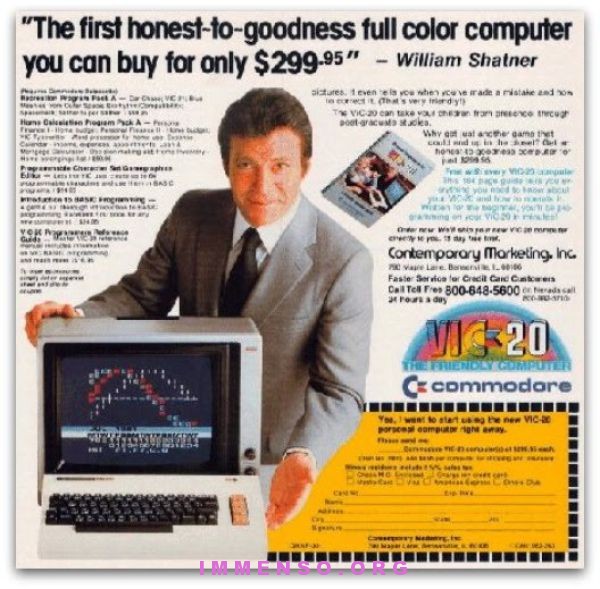


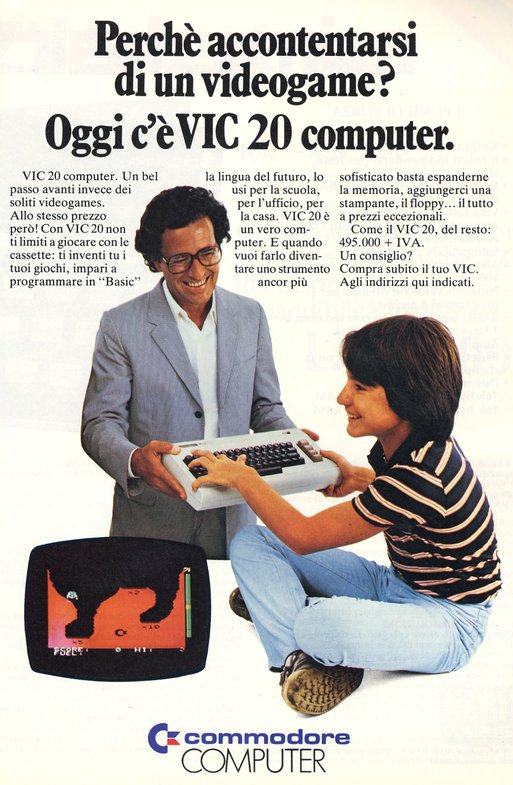
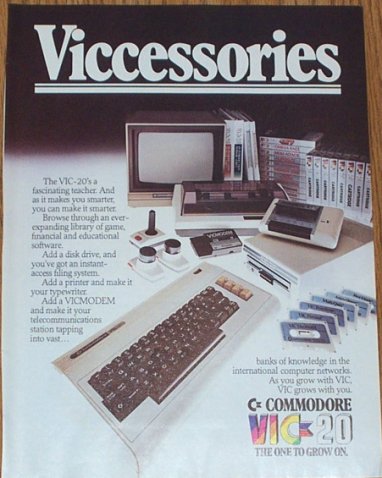

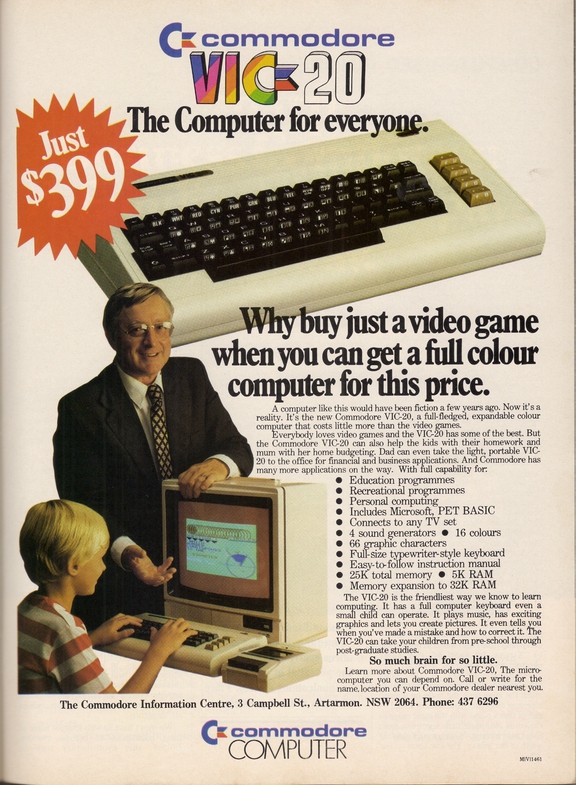
The first mass PC from IBM - IBM PC , 1981. Worked on an Intel 8088, 4.77 MHz processor. Software - IBM Basic.
Price for top configuration: $ 3005 ($ 7994)


In June 1981, the TI-99/2 from Texas Instruments appeared. He had a graphic mode, although he displayed everything in black and white.
Price: $ 99.95 ($ 235)


TI-99 / 4A was able to display 16 colors at a resolution of 512 × 424 or 256 colors at a resolution of 256 × 424.
Price: $ 525 ($ 1396)

From 1981 to 1983, the company Sinclair vyskal ZX81 - the predecessor of the famous Spectrum. The computer was delivered as a set for self-assembly or a little more expensive - already assembled. Equipped with a processor Zilog Z80 (3.25 MHz) or its analogue NEC μPD780C-1. The screen could display text in 24 lines of 32 characters. It was also possible to simulate a 64 × 48 pixel graphics mode.
Price for the assembled version: £ 69.99 (£ 227.00)
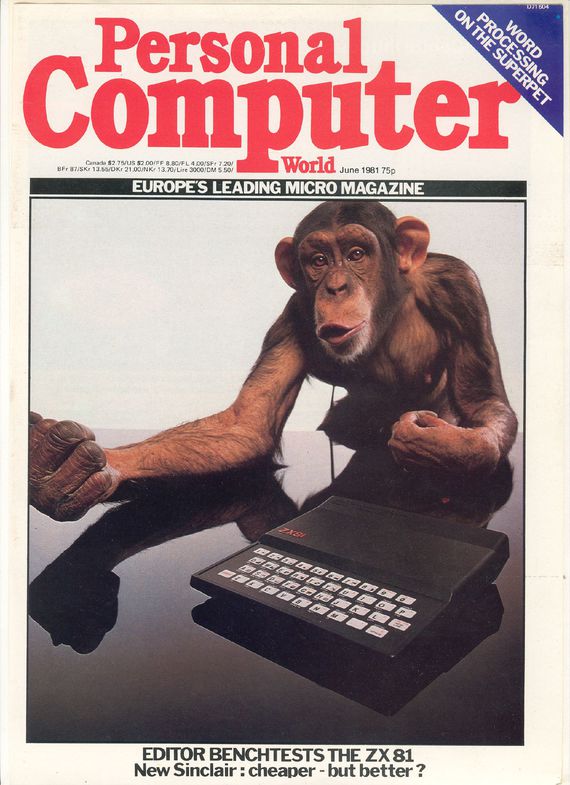


The Kaypro II had a 9 inch green screen and 64 K RAM. They made it, apparently, under the influence of a laptop computer Osborne-1. Sales began in 1982.
Price: $ 1795.00 ($ 4384)

Timex Sinclair 1000. Worked on the company's own operating system - Sinclair BASIC. It went on sale in July 1982 for about a hundred dollars. Positioned it as the cheapest home personal computer.
Price: $ 99.95 ($ 244)

The HP's 80th series in 1982 continued the HP86A with dual floppy, external monitor and 64K RAM.
Price: $ 1795.00 ($ 4384)

In April 1982, the ZX Spectrum appeared - a color home computer from the English company Sinclair. It is often called "Speccy." This computer became the best-selling English computer, and the founder of Sinclair Research Ltd Clive Sinclair for the contribution to the development of British industry received the title "Knight of the Royal Order" with the assignment of the title "Sir".
Price: £ 175 (£ 523)

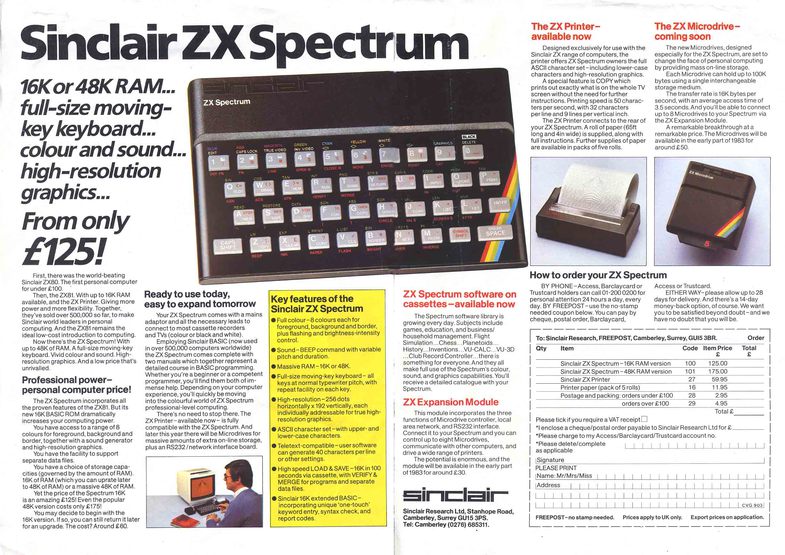
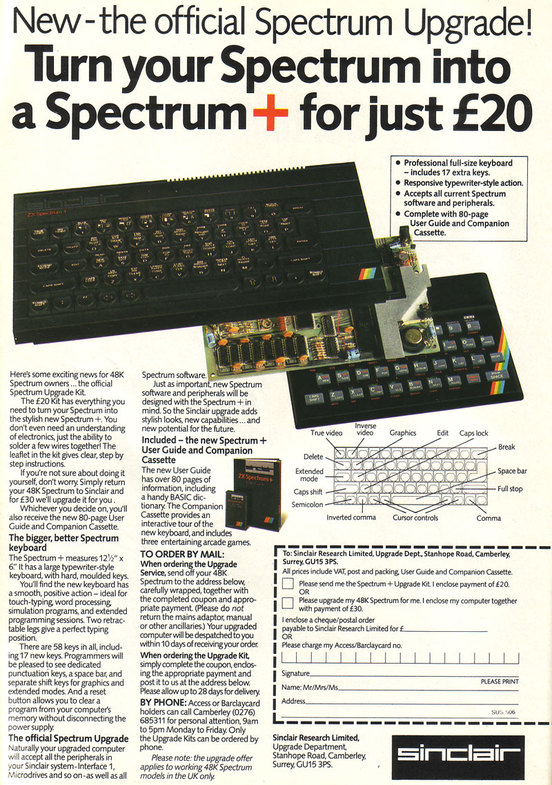
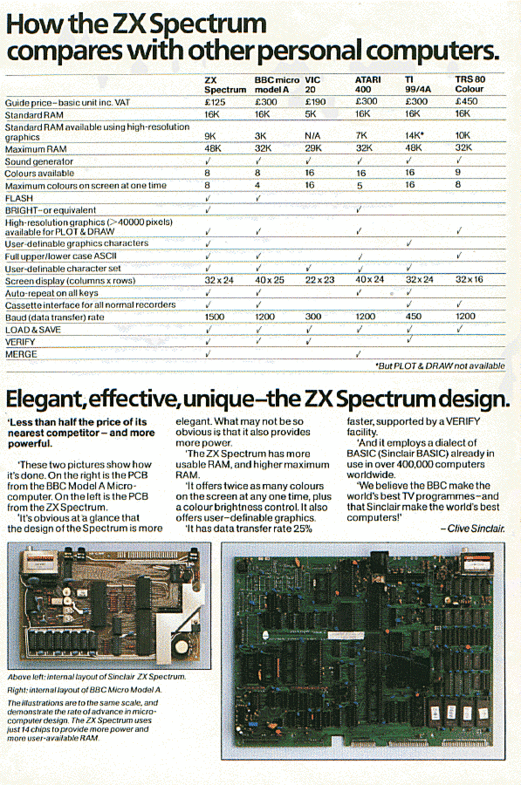
In mid-1983, the price of Kaypro II was reduced by $ 200 - to $ 1,595. This model has been produced since 1981. In 1983, about 10,000 Kaypro II were sold monthly.
Price: $ 1,592 ($ 3,752)

Sales of the ACE1200 desktop computer started in 1983. This is an Apple-II compatible computer with 128K RAM, two integrated floppy drives and a color video card.
Price: $ 2495 ($ 5869)


HP explains why the HP Series 200 Model 16 is better than IBM. Who cares - Configuration Guide for HP Series 20 Computers in pdf.

The IBM 5160, the second-generation IBM PC, has also been manufactured on the Intel 8088 base since March 8, 1983.
Price: $ 8,000 ($ 18,819)


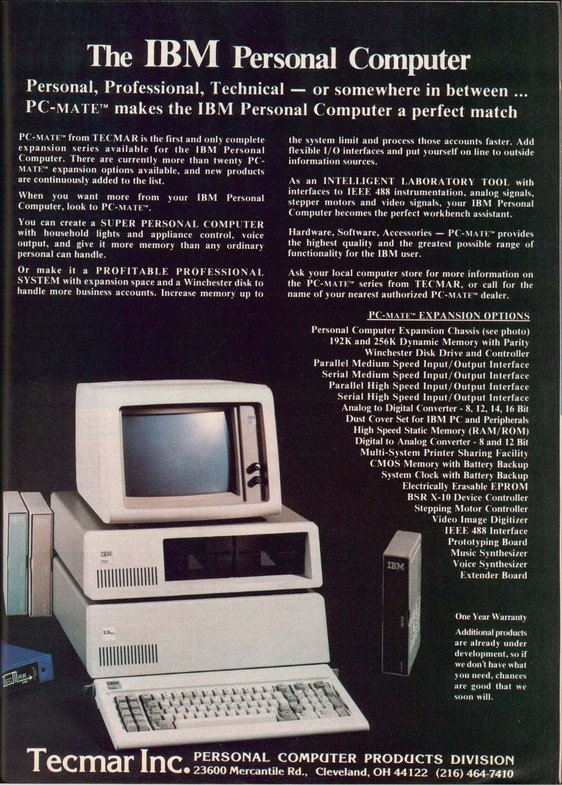
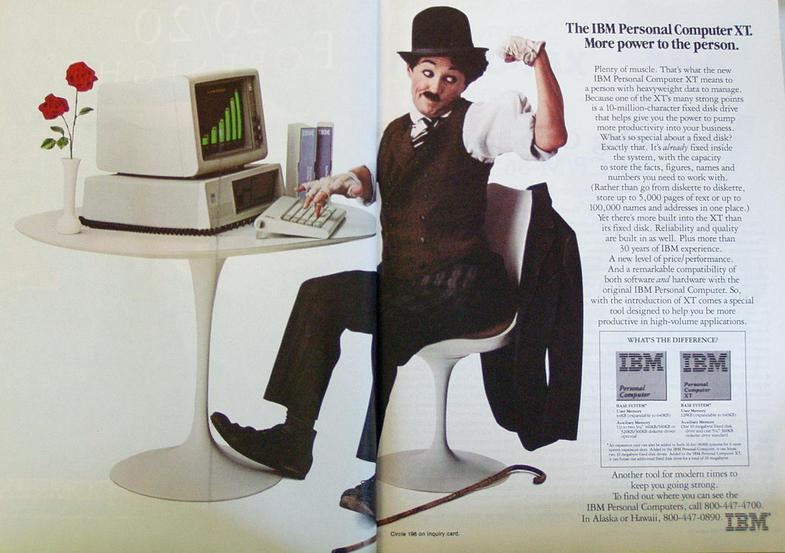
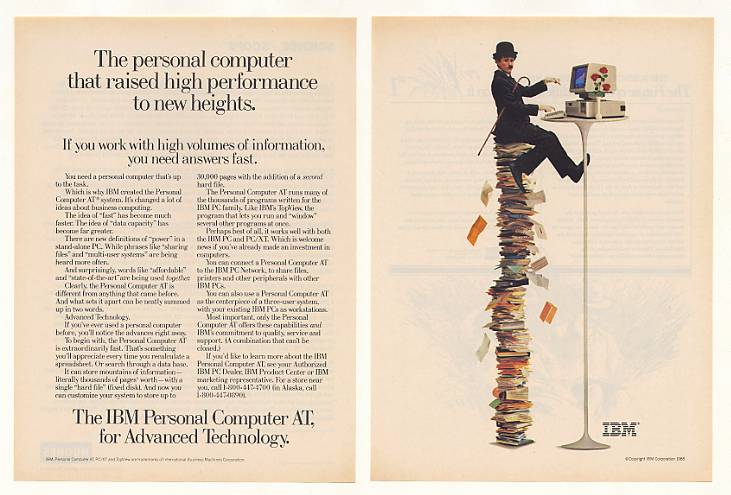

In 1983, Apple began selling Lisa, which Jobs named after his daughter. This computer was much more advanced than the Macintosh. He supported up to 2 MB of RAM and had a protected memory mode. The processor is a Motorola 68000, 5 MHz. Included was an external hard disk of 5 MB.
Price: $ 9,995 ($ 23,512)

The Apple Lisa ad starred Kevin Costner.
The director of Apple’s Macintosh ad is Ridley Scott. The theme is George Orwell's dystopian novel "1984", published in 1949. The Macintosh was the first mass-produced computer with a mouse and a fully graphical user interface.
Price: $ 2495 ($ 5655)
Print advertising Macintosh.


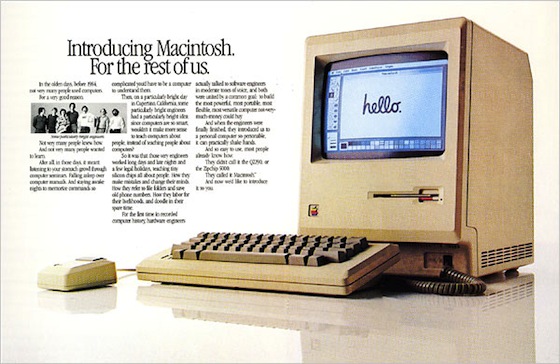
And here is a black and white newspaper.
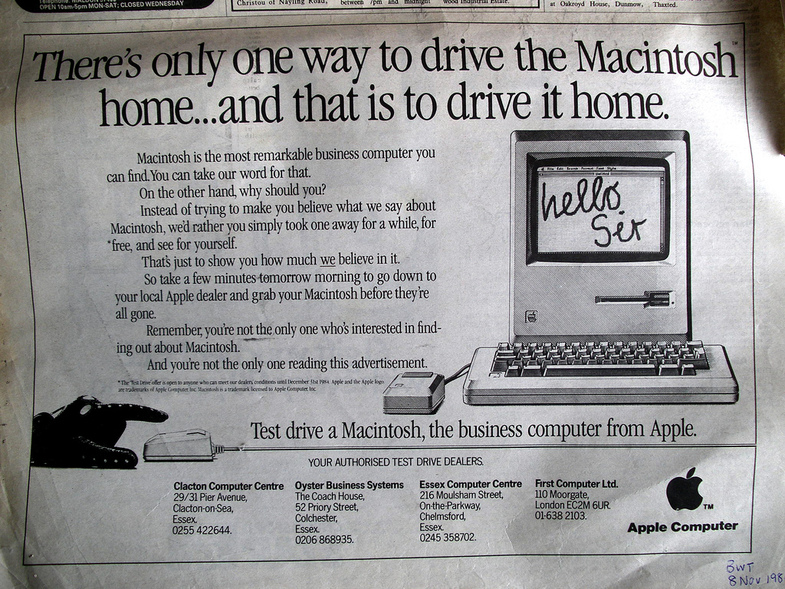
Do you recognize these guys?
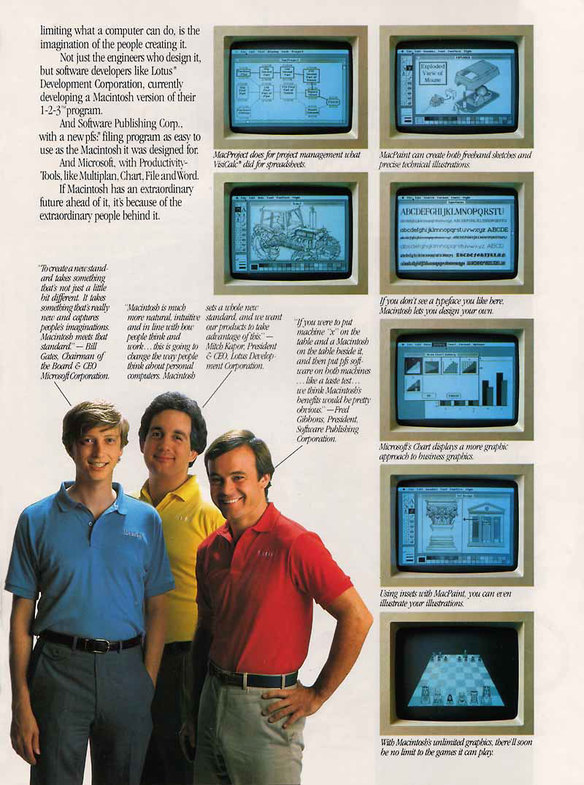
In 1984, the Tandy 1000 color computer appeared. It was equipped with an 8088-2 processor with a clock frequency of 7.16 MHz and one or two floppy drives. And even ports for the light pen and for headphones.
Price: $ 1,199 ($ 2,717)
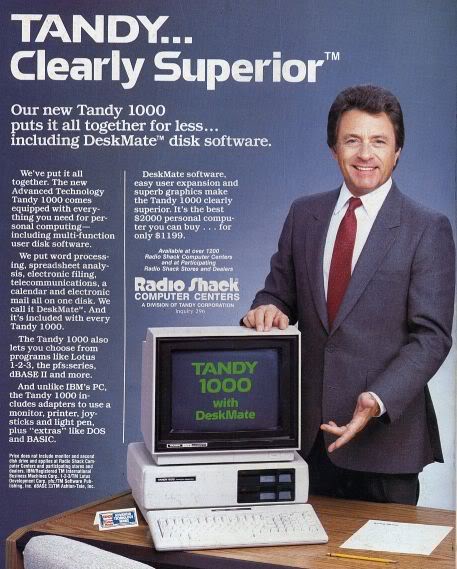

Tandy line:
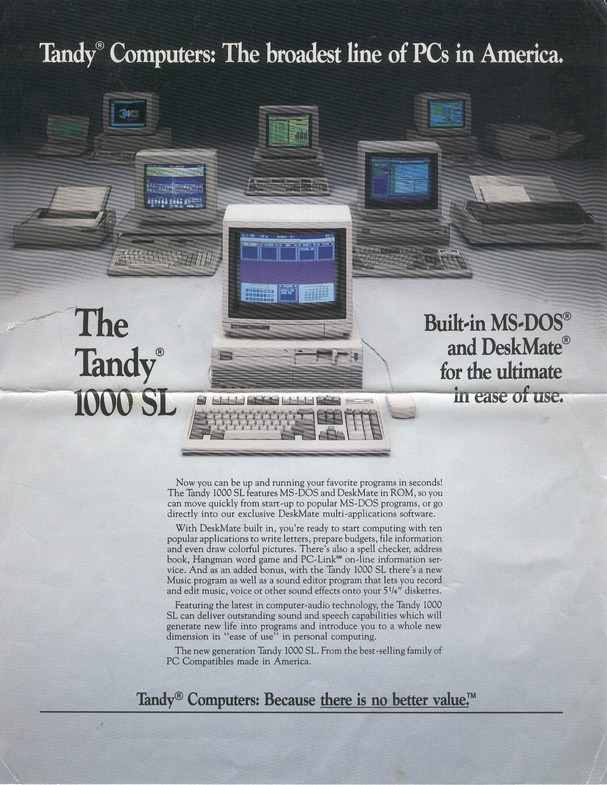
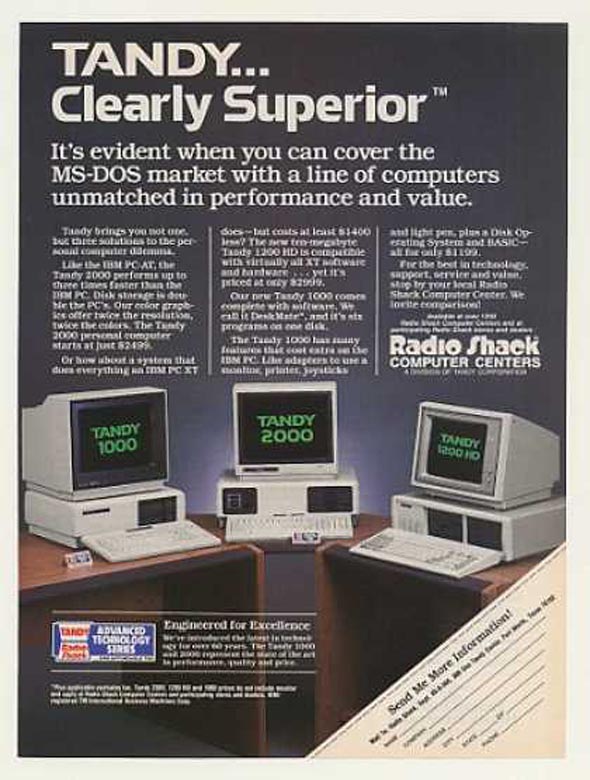
The company NCR, specializing in products for retail chains, banking and financial industries, tourism and medical industries since 1894, in 1984 released NCR PC4. The computer was sold in six versions - with a monochrome or color display, one or two 5.25 "DS-DD floppy or 10 MB disk in place of the second floppy disk drive. This model received the award of the German International Forum Design.
Price: $ 2,400 ($ 5439)

Sales of the Sony Hit-Bit 75 in Japan began in 1984. It was a computer based on the Zilog Z80 processor. Clock frequency - 3,58 MHz

Commodore’s Amiga 1000 ad in 1984 focused on multimedia. Such a demonstration of possibilities was arranged: a three-dimensional ball, painted with red and white squares, flew in a three-dimensional room and crashed against its walls.
Price: $ 1500 ($ 3150)

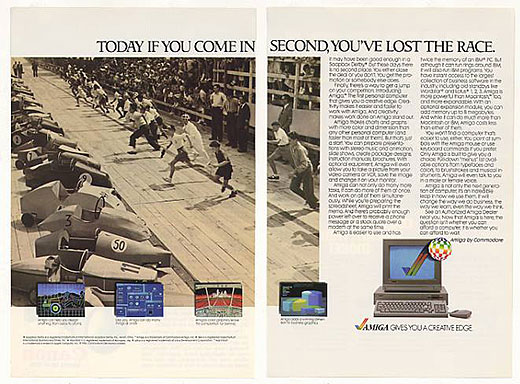
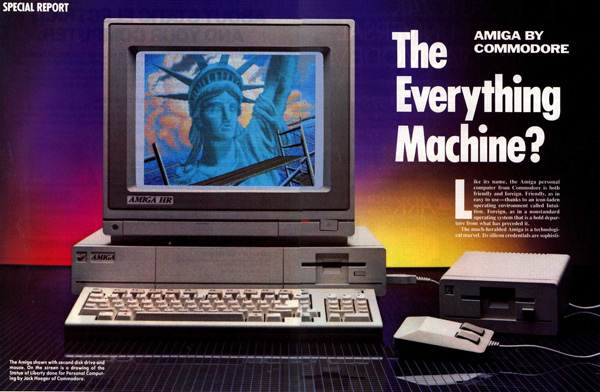


In 1984 came the 8-bit personal computer Amstrad CPC 464 - a competitor to Commodore 64 and Sinclair ZX Spectrum. He worked on the Zilog Z80 2.5 MHz processor and was equipped with 64 KB of RAM, had a tape recorder and the OS Locomotive BASIC 1.0. The CPC line of computers was a success - about 3 million copies were sold.
Price with green screen: £ 249 (£ 678)
Price with color screen: £ 359 (£ 977)

In the USSR, too, not bast shoes were woven - since 1984 the AGAT-4 has been serially produced, a training computer with an 8-bit processor with a clock frequency of 1 MHz, with Apple OS DOS 3.3. The kit included two gaming console. Unfortunately, the advertisement was tight ...
Price: 4000 rubles

NCR PC6 appeared in stores in 1985. The processor is already 8 MHz, not 4.77, as in the previous model.
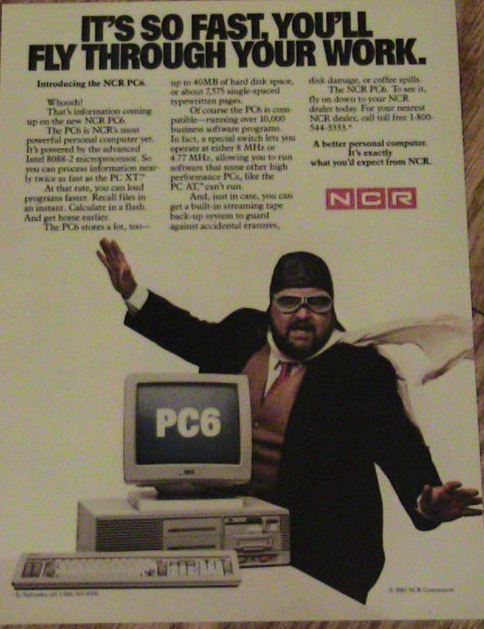
The company Tandy in 1985 decided to improve the model 1000 - and added a hard drive to it, getting a Tandy 1200 HD. The model was equipped with 256KB of RAM with the possibility of tuning up to 640Kb, a hard disk of 10 megabytes. Additionally, you could buy a color monitor for $ 549.
Price:
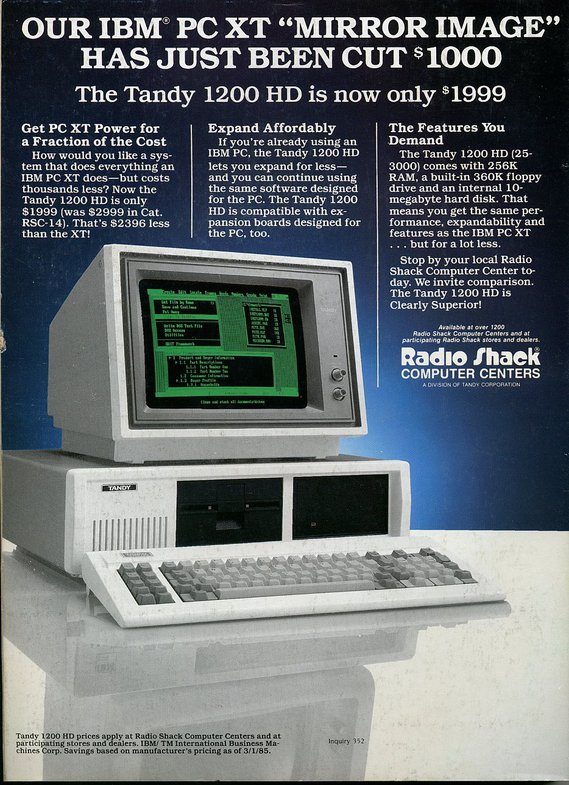
1986: Amiga ads show again what kind of graphics a computer is capable of.
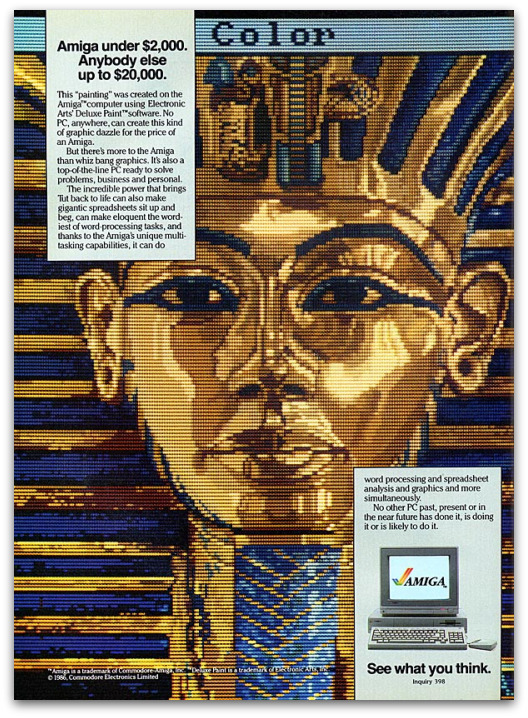
The Tandy 1000 SX went on sale in 1986.
Price: $ 990 ($ 2,079)


This Speccy model went on sale in the UK in 1986.
Price: £ 179.95 (£ 446)

In April 1986, IBM introduced the PC Convertible, its first laptop. It was equipped with an 8088 processor with a frequency of 4.77 MHz, 256 KB of RAM, with the possibility of expansion to 512 KB. Weight - 6 kg and carrying handle. Probably, it was one of the first transforming laptops: after all, the display was detachable, which is clearly seen in this advertisement. And again - Charlie Chaplin!
Price: $ 2000 ($ 4201)
In 1986, Compaq managed to overtake IBM in some ways: the DeskPro 386 was the first personal computer running the new Intel 80386 processor. IBM only released a PC on this processor 7 months later, losing its status as a technology leader. So the market was presented 32-bit architecture.
Price: $ 5000 ($ 10,503)
“Compaq entered the corporate history, becoming the first company to pass the $ 1 billion mark in sales revenue five years after it began to operate.” Compaq 1988 Annual Report.
Classic TV advertising.
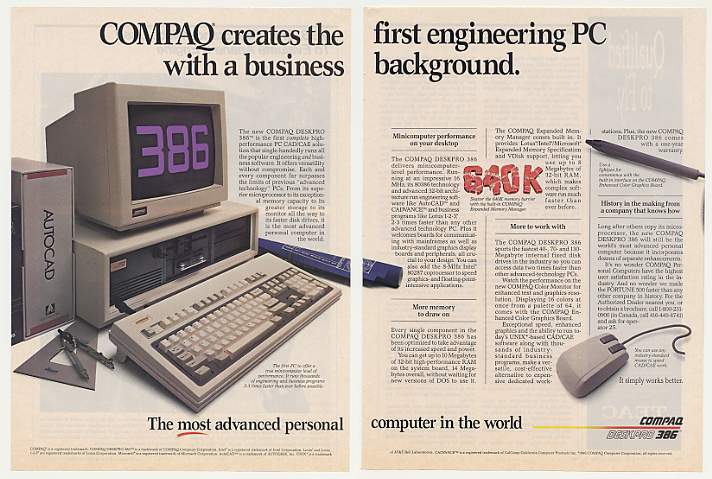
In 1987, IBM decided to oust other manufacturers from the American computer market. To do this, the company launched the IBM PS / 2 series on Intel 80286 and Intel 80386 processors. The company decided to use closed standards that prevent their use by third-party developers without expensive licensing. OS / 2 was supposed to work only on PS / 2 computers. Feint ears failed - the success of the series reached only in the corporate segment.
Price: $ 2,295 ($ 4,768)
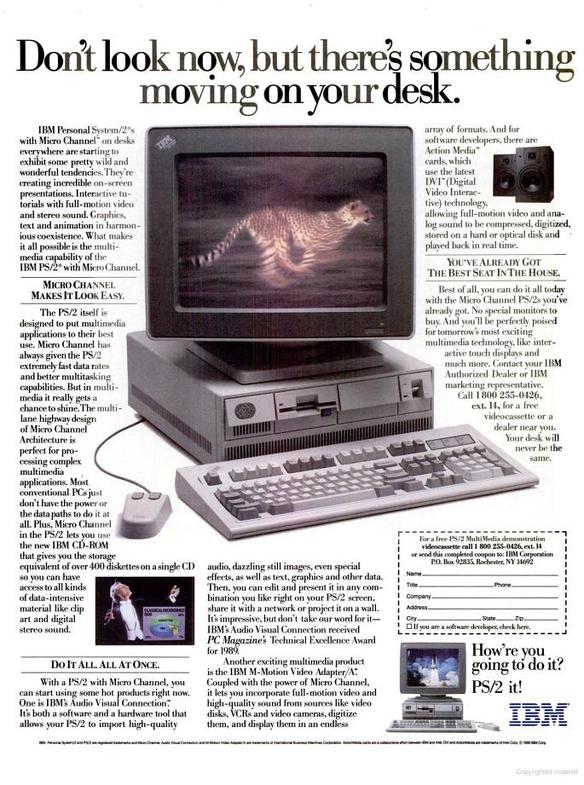
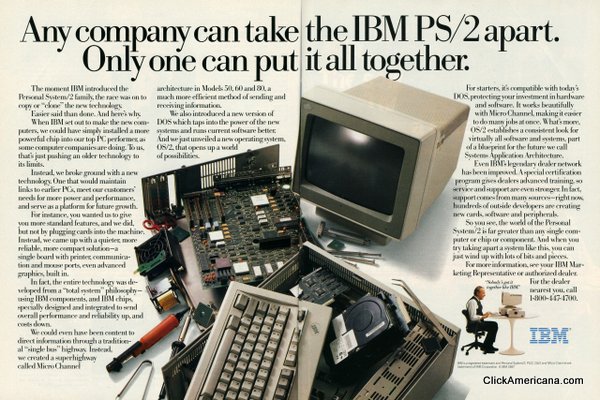
The creation of Steve Jobs NeXT Computer with UNIX-like OS NeXTSTEP was produced from 1988 to 1990. The first couple of years the computer was sold only to higher educational institutions at a special price of $ 6,500, and in 1990 it went on sale in public - this miracle of technology could be bought for $ 9,999. There was no commercial success - it was too cool for its time, and therefore too expensive. Someone wonders what the first CENT httpd web server and WorldWIdeWeb internet browser was created on NeXT Computer.
It is worth noting that the NeXT's RAM reached 64 megabytes, and the resolution was 1120 × 832 pixels, which gives 931,840 pixels, which is more than 1024 * 768, the standard resolution of computers from the mid-90s .
Price: $ 9,999 ($ 18,206)
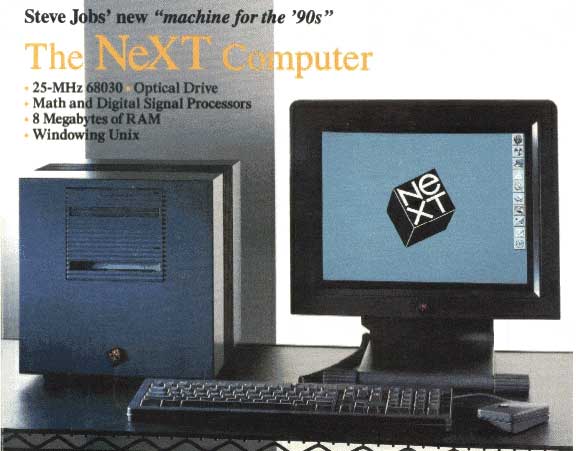
To be continued…
It is interesting:
The history of personal computers in advertising. Part 1: 1970s
Advertising laptops of the 1980s and 1990s
Old advertisements for cell phones and smartphones (from the 1980s to the end of the 2000s)
Prototypes of Apple devices 30 years ago
Living computer museum
Recalculated prices using this calculator .
In a previous publication on the history of computers in advertising, I covered the period from the end of 1960 to 1979. The time has come to recall the 1980s: here you will find Speccy, NeXT, Macintosh, and other computers from the time when a 10 MB hard drive cost more than $ 3,000.
After a brief description of the exhibits, I added prices at the time of their sale, and also recalculated them for 2013 (in brackets).
')
Enjoy watching!
Please do not be too strict with the design of the post: I could not find some of the images in the best quality.
If you have something to supplement the collection - please write about it, please, in the comments or in personal messages.
Previous and next parts:
The history of personal computers in advertising. Part 1: 1970s
The history of personal computers in advertising. Part 3: 1990s




In January 1980, Hewlett-Packard launched the first computer in the series 80 - HP85A. This computer is designed to work with engineering and control applications.
Price: $ 2,750 ($ 8,232)


In the 1980s, Sinclair began to produce a personal computer ZX80. It was the first computer in the UK, the price for which did not exceed £ 100.
Price: $ 199.95 ($ 598.55)



Commodore VIC-20 8-bit color home computer. “Why buy a video game when you can buy a computer for the same money?” It became the first microcomputer whose sales exceeded 1 million units. In total, the people took 2.5 million copies. The initial price was $ 299.95, but then it was lowered to as much as $ 55 - lower than the cost price. We won at the expense of accessories and software. William Shetner (Star Trek) participated in the campaign
Price: $ 55 ($ 164.64)







The first mass PC from IBM - IBM PC , 1981. Worked on an Intel 8088, 4.77 MHz processor. Software - IBM Basic.
Price for top configuration: $ 3005 ($ 7994)


In June 1981, the TI-99/2 from Texas Instruments appeared. He had a graphic mode, although he displayed everything in black and white.
Price: $ 99.95 ($ 235)


TI-99 / 4A was able to display 16 colors at a resolution of 512 × 424 or 256 colors at a resolution of 256 × 424.
Price: $ 525 ($ 1396)

From 1981 to 1983, the company Sinclair vyskal ZX81 - the predecessor of the famous Spectrum. The computer was delivered as a set for self-assembly or a little more expensive - already assembled. Equipped with a processor Zilog Z80 (3.25 MHz) or its analogue NEC μPD780C-1. The screen could display text in 24 lines of 32 characters. It was also possible to simulate a 64 × 48 pixel graphics mode.
Price for the assembled version: £ 69.99 (£ 227.00)



The Kaypro II had a 9 inch green screen and 64 K RAM. They made it, apparently, under the influence of a laptop computer Osborne-1. Sales began in 1982.
Price: $ 1795.00 ($ 4384)

Timex Sinclair 1000. Worked on the company's own operating system - Sinclair BASIC. It went on sale in July 1982 for about a hundred dollars. Positioned it as the cheapest home personal computer.
Price: $ 99.95 ($ 244)

The HP's 80th series in 1982 continued the HP86A with dual floppy, external monitor and 64K RAM.
Price: $ 1795.00 ($ 4384)

In April 1982, the ZX Spectrum appeared - a color home computer from the English company Sinclair. It is often called "Speccy." This computer became the best-selling English computer, and the founder of Sinclair Research Ltd Clive Sinclair for the contribution to the development of British industry received the title "Knight of the Royal Order" with the assignment of the title "Sir".
Price: £ 175 (£ 523)




In mid-1983, the price of Kaypro II was reduced by $ 200 - to $ 1,595. This model has been produced since 1981. In 1983, about 10,000 Kaypro II were sold monthly.
Price: $ 1,592 ($ 3,752)

Sales of the ACE1200 desktop computer started in 1983. This is an Apple-II compatible computer with 128K RAM, two integrated floppy drives and a color video card.
Price: $ 2495 ($ 5869)


HP explains why the HP Series 200 Model 16 is better than IBM. Who cares - Configuration Guide for HP Series 20 Computers in pdf.

The IBM 5160, the second-generation IBM PC, has also been manufactured on the Intel 8088 base since March 8, 1983.
Price: $ 8,000 ($ 18,819)






In 1983, Apple began selling Lisa, which Jobs named after his daughter. This computer was much more advanced than the Macintosh. He supported up to 2 MB of RAM and had a protected memory mode. The processor is a Motorola 68000, 5 MHz. Included was an external hard disk of 5 MB.
Price: $ 9,995 ($ 23,512)

The Apple Lisa ad starred Kevin Costner.
The director of Apple’s Macintosh ad is Ridley Scott. The theme is George Orwell's dystopian novel "1984", published in 1949. The Macintosh was the first mass-produced computer with a mouse and a fully graphical user interface.
Price: $ 2495 ($ 5655)
Print advertising Macintosh.



And here is a black and white newspaper.

Do you recognize these guys?

In 1984, the Tandy 1000 color computer appeared. It was equipped with an 8088-2 processor with a clock frequency of 7.16 MHz and one or two floppy drives. And even ports for the light pen and for headphones.
Price: $ 1,199 ($ 2,717)


Tandy line:


The company NCR, specializing in products for retail chains, banking and financial industries, tourism and medical industries since 1894, in 1984 released NCR PC4. The computer was sold in six versions - with a monochrome or color display, one or two 5.25 "DS-DD floppy or 10 MB disk in place of the second floppy disk drive. This model received the award of the German International Forum Design.
Price: $ 2,400 ($ 5439)

Sales of the Sony Hit-Bit 75 in Japan began in 1984. It was a computer based on the Zilog Z80 processor. Clock frequency - 3,58 MHz

Commodore’s Amiga 1000 ad in 1984 focused on multimedia. Such a demonstration of possibilities was arranged: a three-dimensional ball, painted with red and white squares, flew in a three-dimensional room and crashed against its walls.
Price: $ 1500 ($ 3150)





In 1984 came the 8-bit personal computer Amstrad CPC 464 - a competitor to Commodore 64 and Sinclair ZX Spectrum. He worked on the Zilog Z80 2.5 MHz processor and was equipped with 64 KB of RAM, had a tape recorder and the OS Locomotive BASIC 1.0. The CPC line of computers was a success - about 3 million copies were sold.
Price with green screen: £ 249 (£ 678)
Price with color screen: £ 359 (£ 977)

In the USSR, too, not bast shoes were woven - since 1984 the AGAT-4 has been serially produced, a training computer with an 8-bit processor with a clock frequency of 1 MHz, with Apple OS DOS 3.3. The kit included two gaming console. Unfortunately, the advertisement was tight ...
Price: 4000 rubles

NCR PC6 appeared in stores in 1985. The processor is already 8 MHz, not 4.77, as in the previous model.

The company Tandy in 1985 decided to improve the model 1000 - and added a hard drive to it, getting a Tandy 1200 HD. The model was equipped with 256KB of RAM with the possibility of tuning up to 640Kb, a hard disk of 10 megabytes. Additionally, you could buy a color monitor for $ 549.
Price:

1986: Amiga ads show again what kind of graphics a computer is capable of.

The Tandy 1000 SX went on sale in 1986.
Price: $ 990 ($ 2,079)


This Speccy model went on sale in the UK in 1986.
Price: £ 179.95 (£ 446)

In April 1986, IBM introduced the PC Convertible, its first laptop. It was equipped with an 8088 processor with a frequency of 4.77 MHz, 256 KB of RAM, with the possibility of expansion to 512 KB. Weight - 6 kg and carrying handle. Probably, it was one of the first transforming laptops: after all, the display was detachable, which is clearly seen in this advertisement. And again - Charlie Chaplin!
Price: $ 2000 ($ 4201)
In 1986, Compaq managed to overtake IBM in some ways: the DeskPro 386 was the first personal computer running the new Intel 80386 processor. IBM only released a PC on this processor 7 months later, losing its status as a technology leader. So the market was presented 32-bit architecture.
Price: $ 5000 ($ 10,503)
“Compaq entered the corporate history, becoming the first company to pass the $ 1 billion mark in sales revenue five years after it began to operate.” Compaq 1988 Annual Report.
Classic TV advertising.

In 1987, IBM decided to oust other manufacturers from the American computer market. To do this, the company launched the IBM PS / 2 series on Intel 80286 and Intel 80386 processors. The company decided to use closed standards that prevent their use by third-party developers without expensive licensing. OS / 2 was supposed to work only on PS / 2 computers. Feint ears failed - the success of the series reached only in the corporate segment.
Price: $ 2,295 ($ 4,768)


The creation of Steve Jobs NeXT Computer with UNIX-like OS NeXTSTEP was produced from 1988 to 1990. The first couple of years the computer was sold only to higher educational institutions at a special price of $ 6,500, and in 1990 it went on sale in public - this miracle of technology could be bought for $ 9,999. There was no commercial success - it was too cool for its time, and therefore too expensive. Someone wonders what the first CENT httpd web server and WorldWIdeWeb internet browser was created on NeXT Computer.
It is worth noting that the NeXT's RAM reached 64 megabytes, and the resolution was 1120 × 832 pixels, which gives 931,840 pixels, which is more than 1024 * 768, the standard resolution of computers from the mid-90s .
Price: $ 9,999 ($ 18,206)

To be continued…
It is interesting:
The history of personal computers in advertising. Part 1: 1970s
Advertising laptops of the 1980s and 1990s
Old advertisements for cell phones and smartphones (from the 1980s to the end of the 2000s)
Prototypes of Apple devices 30 years ago
Living computer museum
Recalculated prices using this calculator .
Source: https://habr.com/ru/post/192182/
All Articles